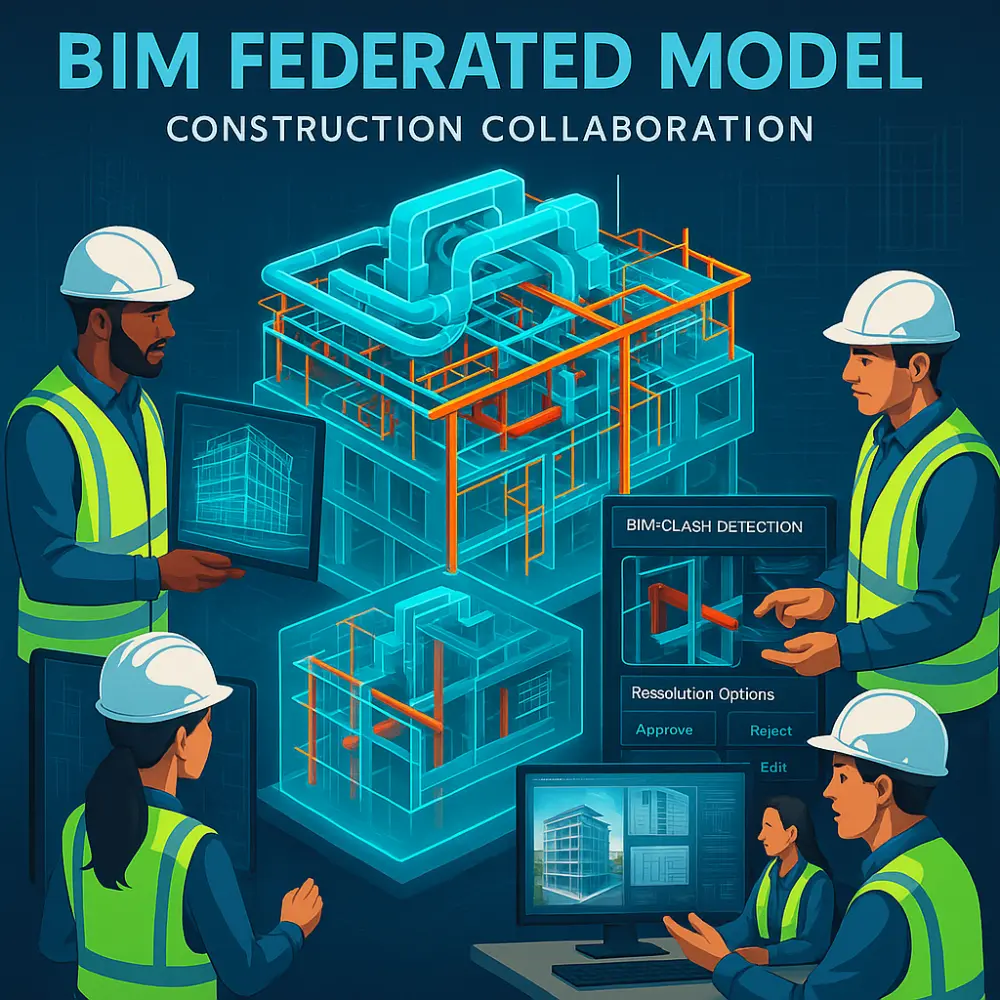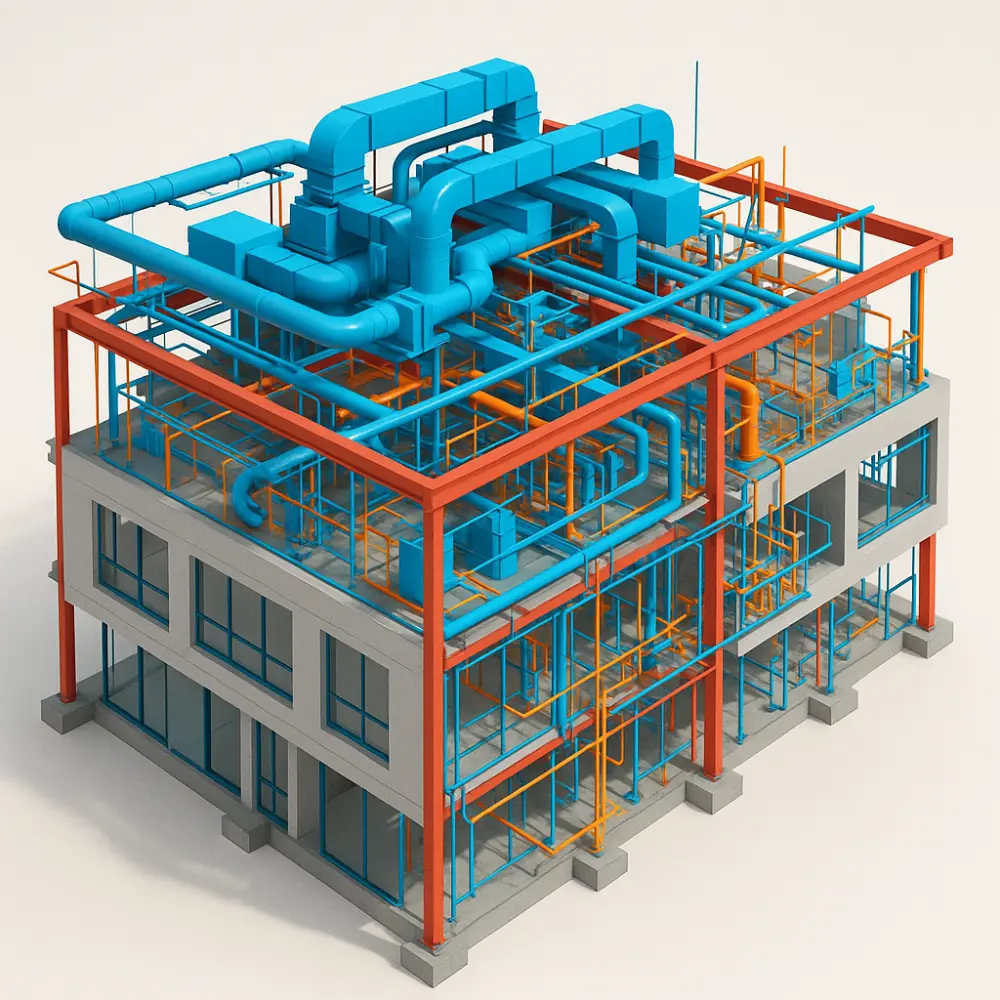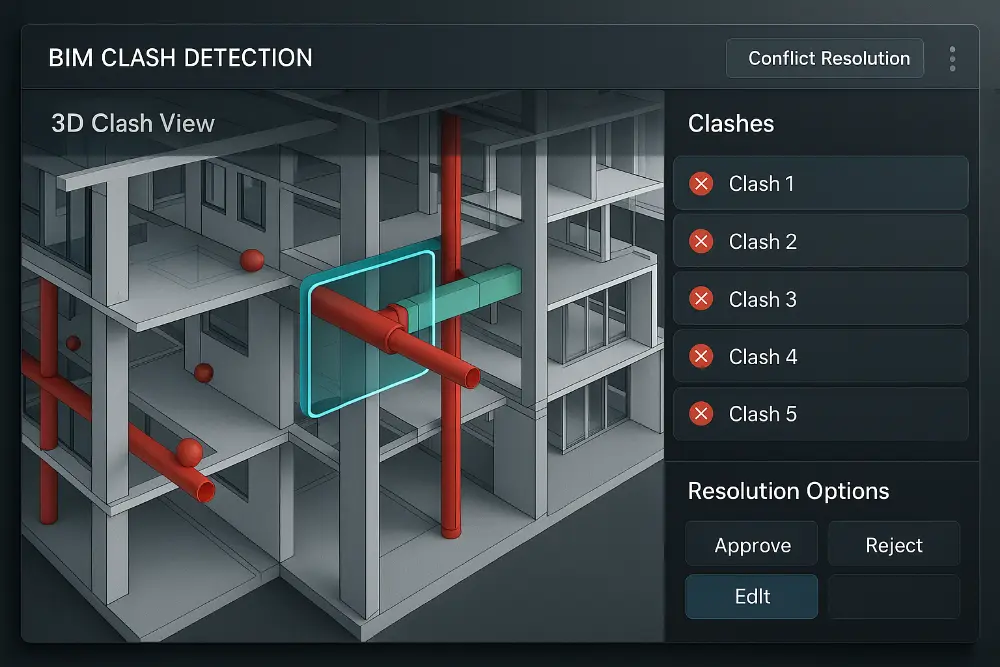
Building Information Modeling (BIM) has revolutionized how construction projects are planned, designed, and executed. At the heart of this transformation lies a powerful concept that's reshaping multi-disciplinary collaboration: the federated model. This comprehensive approach to BIM coordination has become the backbone of modern construction projects, enabling seamless integration of complex building systems while maintaining individual discipline autonomy.
A federated model represents the integration of multiple discipline-specific models—architectural, structural, mechanical, electrical, and plumbing (MEP)—into a single, cohesive digital representation. Unlike traditional approaches where each discipline works in isolation, federated modeling creates a unified environment where all project stakeholders can visualize, coordinate, and collaborate in real-time.
The significance of federated models extends far beyond simple file aggregation. These sophisticated digital environments serve as the central nervous system for construction projects, facilitating everything from clash detection and design coordination to cost estimation and facility management. As the construction industry continues its digital transformation, understanding and implementing federated models has become essential for project success.
Understanding Federated Models: The Foundation of Modern BIM
What Defines a Federated Model?
A federated model is fundamentally different from traditional monolithic BIM approaches. Rather than forcing all disciplines to work within a single model file, federation allows each team to maintain their specialized models while creating a unified view for project coordination. This approach preserves the integrity of discipline-specific workflows while enabling comprehensive project visualization.
Did You Know?
Leading BIM coordination platforms can federate over 45 individual models from different disciplines in large-scale projects, maintaining real-time synchronization across all systems.
The federated approach operates on the principle of model autonomy with coordination unity. Each discipline—whether architectural, structural, or MEP—develops their models using their preferred software platforms. These individual models are then brought together through specialized coordination software like Navisworks, Solibri, or BIM 360, creating a comprehensive project view without compromising individual model integrity.
Core Components of Federation
Successful federated models require several key components working in harmony:
- Individual Discipline Models: Each team creates detailed models specific to their trade, including architectural layouts, structural frameworks, mechanical systems, electrical distribution, and plumbing networks.
- Common Data Environment (CDE): A centralized platform where all models are stored, shared, and coordinated. This environment ensures that all team members work with the most current information while maintaining version control. Learn more about CDE in depth here .
- Coordination Software: Specialized platforms that can read multiple file formats (IFC, RVT, DWG) and combine them into a unified federated view. These tools provide clash detection, visualization, and reporting capabilities.
- Standardized Protocols: Clear guidelines for file naming, coordinate systems, levels of development (LOD), and data exchange formats ensure consistency across all federated components.
The Strategic Importance of Federated Models
Enhanced Collaboration through Digital Integration
Federated models transform how construction teams collaborate by breaking down traditional silos between disciplines. When architectural, structural, and MEP teams can see their work in context with others, communication improves dramatically, and design decisions become more informed.
Did You Know?
Projects using federated BIM models report up to 15% reduction in coordination issues and 10% improvement in construction schedule accuracy compared to traditional methods.
The collaborative benefits extend beyond the design phase. During construction, federated models serve as the single source of truth for all trades, enabling real-time coordination and reducing the likelihood of conflicts in the field. This approach has proven particularly valuable in complex projects where multiple systems must occupy the same spatial envelope.
Real-Time Clash Detection and Resolution

One of the most significant advantages of federated models is their ability to identify conflicts between building systems before construction begins. Advanced clash detection algorithms can automatically identify hard clashes (physical interferences) and soft clashes (clearance violations) across all disciplines.
The clash detection process typically involves:
- Automated Scanning: Software continuously monitors the federated model for geometric conflicts between different systems.
- Prioritization: Clashes are categorized by severity and impact, allowing teams to focus on the most critical issues first.
- Resolution Tracking: Changes made to resolve clashes are tracked and verified to ensure solutions don't create new conflicts.
- Documentation: Comprehensive clash reports provide detailed information for coordination meetings and field resolution.
Data-Driven Decision Making
Federated models provide unprecedented access to project data, enabling more informed decision-making throughout the project lifecycle. By aggregating information from all disciplines, project teams can analyze impacts, optimize solutions, and make decisions based on comprehensive data rather than isolated discipline perspectives.

This data-rich environment supports various analyses including: - Cost impact assessments for design changes - Schedule optimization based on system interdependencies - Sustainability analysis across all building systems - Facility management planning for post-construction operations
Implementing Federated Models: Best Practices and Workflows

Establishing Federation Standards
Successful federated model implementation begins with establishing clear standards and protocols. These guidelines ensure that all discipline models can be effectively combined and coordinated.
- All models must reference the same project coordinate system to ensure proper spatial alignment.
- Consistent LOD requirements across disciplines ensure appropriate detail levels for effective coordination.
- Standardized naming protocols facilitate automated model federation and reduce coordination errors.
- Clear procedures for model updates and version control prevent coordination conflicts and ensure all teams work with current information.
Software Tools and Platforms
The success of federated models depends heavily on selecting appropriate software tools that can handle the complexity of multi-discipline coordination.
- Autodesk Navisworks remains the industry standard for federated model coordination, offering robust clash detection, visualization, and reporting capabilities. The platform supports virtually all major CAD and BIM file formats, making it ideal for heterogeneous software environments.
- Autodesk BIM 360 provides cloud-based collaboration capabilities, enabling distributed teams to work with federated models in real-time. The platform's integration with field management tools makes it particularly valuable for construction-phase coordination.
- Solibri offers advanced model checking and quality assurance capabilities, making it excellent for ensuring federated model integrity and compliance with project standards.
Did You Know?
Modern federated BIM platforms can process point cloud data alongside traditional models, enabling as-built verification and renovation project coordination.
For comprehensive BIM coordination and federated model implementation, selecting the right service provider is crucial. Professional BIM service providers offer specialized expertise in model federation, clash detection, and coordination workflows. When choosing a top BIM service provider , consider their experience with federated model projects, software proficiency, and ability to manage complex multi-discipline coordination. Leading providers offer end-to-end services including model development, federation setup, clash detection, and ongoing coordination support throughout the project lifecycle.
Advanced Applications and Future Trends
4D and 5D Integration
Modern federated models extend beyond 3D geometry to incorporate time (4D) and cost (5D) dimensions. This integration enables sophisticated project planning and management capabilities.
- 4D Scheduling Integration: Linking federated models to construction schedules creates powerful visualization tools that show how projects will be built over time. This capability helps identify scheduling conflicts, optimize construction sequences, and communicate project plans to stakeholders.
- 5D Cost Integration: Incorporating cost data into federated models enables real-time cost tracking, change impact analysis, and accurate project budgeting. When design changes occur, their cost implications can be immediately assessed across all affected disciplines.
Digital Twin Development
Federated models increasingly serve as the foundation for digital twins—living digital representations that continue evolving throughout a building's lifecycle. These systems enable:
- Predictive Maintenance: By connecting federated models to building sensors and IoT systems, facility managers can predict maintenance needs and optimize building performance.
- Space Management: Detailed federated models support advanced space planning and utilization analysis, helping optimize building operations.
- Energy Optimization: Integration with building management systems enables continuous energy performance optimization based on actual usage patterns.
Real-World Success Stories
The Shard, London: Pioneering Federated Model Implementation

The Shard's construction team utilized federated BIM models to coordinate one of Europe's most complex high-rise projects. By integrating architectural, structural, and MEP models, the project team significantly reduced construction time and minimized costly rework.
Did You Know?
The Shard project coordinated over 30 individual discipline models through federated BIM, demonstrating the scalability of this approach for mega-projects.
Dubai Mall Expansion: Managing Complexity through Federation

The Dubai Mall expansion project showcased how federated models can manage extraordinary complexity in active construction environments. The project team used federated coordination to sequence construction activities while maintaining mall operations, demonstrating the practical benefits of comprehensive model integration.
Quality Assurance and Standards Compliance
Model Validation Protocols
Ensuring federated model quality requires systematic validation protocols that verify both individual model integrity and coordination accuracy.
- Geometric Validation: Automated checks verify that all models align correctly within the federated environment and that geometric relationships are maintained.
- Data Integrity Verification: Systems check that all required data elements are present and properly formatted across federated components.
- Standards Compliance: Regular audits ensure that federated models comply with relevant industry standards including IFC protocols and project-specific BIM requirements.
Continuous Quality Improvement
Leading organizations implement continuous improvement processes that refine federated model workflows based on project experience and evolving industry standards.
Challenges and Solutions in Federated Model Implementation

Technical Challenges
- Interoperability Issues: Different software platforms may not perfectly translate data during federation. Solution: Establish clear IFC export protocols and conduct regular interoperability testing.
- Performance Optimization: Large federated models can become unwieldy and slow to manipulate. Solution: Implement model optimization strategies including level-of-detail management and strategic model segmentation.
- Version Control: Managing updates across multiple federated models requires sophisticated coordination. Solution: Implement automated notification systems and clear update protocols.
Organizational Challenges
- Team Coordination: Federated models require unprecedented levels of coordination between traditionally independent disciplines. Solution: Establish clear roles, responsibilities, and communication protocols.
- Training Requirements: Team members need specialized training to work effectively with federated models. Solution: Invest in comprehensive training programs and ongoing skill development.
Did You Know?
Organizations that invest in comprehensive BIM training see up to 52% reduction in personnel costs due to improved productivity and reduced errors.
The Business Impact of Federated Models
Cost Reduction and ROI
Federated models deliver measurable cost savings through multiple mechanisms:
- Reduced Rework: Early clash detection prevents costly field conflicts, with studies showing up to 30% reduction in construction rework.
- Improved Accuracy: Better coordination leads to more accurate material takeoffs and cost estimates.
- Faster Decision Making: Real-time access to coordinated information enables faster, more informed decisions.
Risk Mitigation
Federated models significantly reduce project risks by:
- Early Issue Identification: Problems are identified and resolved in the digital environment before they impact construction.
- Improved Communication: Better visualization and coordination reduce misunderstandings and conflicts.
- Enhanced Quality Control: Systematic coordination processes improve overall project quality.
Future of Federated Models in Construction
Emerging Technologies
- Artificial Intelligence: AI-powered clash detection and resolution suggestions will automate much of the coordination process.
- Virtual and Augmented Reality: Immersive technologies will enable more intuitive federated model interaction and coordination.
- IoT Integration: Connected sensors will provide real-time data to keep federated models current throughout building operations.
Industry Transformation
Federated models are driving fundamental changes in how construction projects are delivered:
- Integrated Project Delivery: Federated models enable true collaborative project delivery where all stakeholders work from a shared digital foundation.
- Performance-Based Contracting: Better project predictability enables new contracting models based on guaranteed outcomes rather than traditional cost-plus arrangements.
- Lifecycle Value Optimization: Federated models that extend into operations enable optimization of building performance over entire lifecycles.
Why Should We Embrace the Federated Future?
Federated models represent a paradigm shift in construction project delivery, moving from fragmented, discipline-specific approaches to truly integrated, collaborative workflows. As the construction industry faces increasing complexity and rising performance expectations, federated models provide the technological foundation for meeting these challenges.
The evidence is clear: projects utilizing federated BIM models consistently outperform traditional approaches in terms of cost, schedule, and quality outcomes. Organizations that master federated model implementation position themselves as leaders in the digital construction transformation.
Success with federated models requires more than just software implementation—it demands organizational commitment to collaboration, investment in team capabilities, and dedication to continuous improvement. However, the rewards justify the effort: better projects, satisfied clients, and competitive advantage in an increasingly sophisticated marketplace.
Did You Know?
The global BIM market is projected to reach $14.68 billion by 2028, with federated modeling capabilities driving much of this growth as organizations recognize the value of integrated project delivery.
As we look toward the future, federated models will continue evolving, incorporating new technologies and methodologies that further enhance their power and utility. Organizations that begin their federated model journey today will be best positioned to leverage these future innovations and lead the industry's digital transformation.
The question is not whether to adopt federated models, but how quickly organizations can successfully implement them to remain competitive in the modern construction landscape. The future of construction is federated, collaborative, and digital—and that future is now.